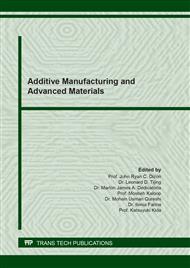[1]
M.E. Rodriguez, Evaluation and design of masonry dwellings in seismic zones, Earthquake Spectra. (2005). https://doi.org/10.1193/1.1904599.
DOI: 10.1193/1.1904599
Google Scholar
[2]
C. Sandoval, S. Calderon, J.L. Almazan, Experimental cyclic response assessment of partially grouted reinforced clay brick masonry walls, Bulletin of Earthquake Engineering 2018 16:7. 16 (2018) 3127–3152. https://doi.org/10.1007/S10518-018-0308-X.
DOI: 10.1007/s10518-018-0308-x
Google Scholar
[3]
M. Shadlou, E. Ahmadi, M.M. Kashani, Micromechanical modelling of mortar joints and brick-mortar interfaces in masonry Structures: A review of recent developments, Structures. (2020). https://doi.org/10.1016/j.istruc.2019.12.017.
DOI: 10.1016/j.istruc.2019.12.017
Google Scholar
[4]
K.F. Abdulla, L.S. Cunningham, M. Gillie, Simulating masonry wall behaviour using a simplified micro-model approach, Engineering Structures. 151 (2017) 349–365. https://doi.org/10.1016/j.engstruct.2017.08.021.
DOI: 10.1016/j.engstruct.2017.08.021
Google Scholar
[5]
N.N. D, S.P. P, R.K. M, Study on Effect of Openings in Seismic Behavior of Masonry Structures, International Research Journal of Engineering and Technology. (2018). www.irjet.net (accessed November 7, 2021).
Google Scholar
[6]
B. Ghiassi, M. Soltani, A.A. Tasnimi, A simplified model for analysis of unreinforced masonry shear walls under combined axial, shear and flexural loading, Engineering Structures. 42 (2012) 396–409. https://doi.org/10.1016/J.ENGSTRUCT.2012.05.002.
DOI: 10.1016/j.engstruct.2012.05.002
Google Scholar
[7]
Z. Liu, A. Crewe, Effects of size and position of openings on in-plane capacity of unreinforced masonry walls, Bulletin of Earthquake Engineering. 18 (2020) 4783–4812. https://doi.org/10.1007/s10518-020-00894-0.
DOI: 10.1007/s10518-020-00894-0
Google Scholar
[8]
A. Borri, M. Corradi, A. De Maria, The Failure of Masonry Walls by Disaggregation and the Masonry Quality Index, Heritage 2020, Vol. 3, Pages 1162-1198. 3 (2020) 1162–1198. https://doi.org/10.3390/HERITAGE3040065.
DOI: 10.3390/heritage3040065
Google Scholar
[9]
C. Qin, Z. Gao, T. Wu, G. Bai, G. Fu, Shear testing and analysis of the response of confined masonry walls with centered openings made with innovative sintered insulation shale blocks, Soil Dynamics and Earthquake Engineering. 150 (2021) 106901. https://doi.org/10.1016/J.SOILDYN.2021.106901.
DOI: 10.1016/j.soildyn.2021.106901
Google Scholar
[10]
T.T. Bui, A. Limam, V. Sarhosis, Failure analysis of masonry wall panels subjected to in-plane and out-of-plane loading using the discrete element method, Https://Doi.Org/10.1080/19648189.2018.1552897. 25 (2019) 876–892. https://doi.org/10.1080/19648189.2018.1552897.
DOI: 10.1080/19648189.2018.1552897
Google Scholar
[11]
S.M.W. Hammoudah, M.T.A. Chaudhary, A.S. Essawy, Analytical and parametric study on masonry infilled reinforced concrete frames using finite element method, Advances in Structural Engineering. 20 (2017) 1891–1906. https://doi.org/10.1177/1369433217700424.
DOI: 10.1177/1369433217700424
Google Scholar
[12]
A.H. Alwathaf, W.A. Thanoon, M.S. Jaafar, Finite-element analysis of an alternative masonry wall system, Proceedings of the Institution of Civil Engineers: Structures and Buildings. (2015). https://doi.org/10.1680/stbu.13.00068.
DOI: 10.1680/stbu.13.00068
Google Scholar
[13]
H.O. Koksal, B. Doran, A.O. Kuruscu, A. Kocak, Elastoplastic Finite Element analysis of masonry shear walls, KSCE Journal of Civil Engineering. (2016). https://doi.org/10.1007/s12205-015-0393-1.
DOI: 10.1007/s12205-015-0393-1
Google Scholar
[14]
E. Sacco, D. Addessi, K. Sab, New trends in mechanics of masonry, Meccanica. (2018). https://doi.org/10.1007/s11012-018-0839-x.
DOI: 10.1007/s11012-018-0839-x
Google Scholar
[15]
A.W. Page, FINITE ELEMENT MODEL FOR MASONRY, ASCE J Struct Div. (1978).
Google Scholar
[16]
H.R. Lotfi, P.B. Shing, Interface Model Applied to Fracture of Masonry Structures, Journal of Structural Engineering. 120 (1994) 63–80. https://doi.org/10.1061/(asce)0733-9445(1994)120:1(63).
DOI: 10.1061/(asce)0733-9445(1994)120:1(63)
Google Scholar
[17]
N. Kumar, R. Amirtham, M. Pandey, Plasticity based approach for failure modelling of unreinforced masonry, Engineering Structures. 80 (2014) 40–52. https://doi.org/10.1016/j.engstruct.2014.08.021.
DOI: 10.1016/j.engstruct.2014.08.021
Google Scholar
[18]
A.J. Aref, K.M. Dolatshahi, A three-dimensional cyclic meso-scale numerical procedure for simulation of unreinforced masonry structures, Computers and Structures. 120 (2013) 9–23. https://doi.org/10.1016/j.compstruc.2013.01.012.
DOI: 10.1016/j.compstruc.2013.01.012
Google Scholar
[19]
D.S. Simulia, ABAQUS documentation, Abaqus 6.12. (2013).
Google Scholar
[20]
ANSYS, Knowledge Creation Diffusion Utilization, (2018).
Google Scholar
[21]
J. Campbell, M. Durán, Numerical model for nonlinear analysis of masonry walls, Revista de La Construccion. 16 (2017) 189–201. https://doi.org/10.7764/RDLC.16.2.189.
DOI: 10.7764/rdlc.16.2.189
Google Scholar
[22]
G. Baloevic, J. Radnic, D. Matesan, N. Grgic, I. Banovic, Comparison of developed numerical macro and micro masonry models for static and dynamic analysis of masonry-infilled steel frames, Latin American Journal of Solids and Structures. 13 (2016) 2251–2265. https://doi.org/10.1590/1679-78252520.
DOI: 10.1590/1679-78252520
Google Scholar
[23]
P. Lourenco, J. Rots, J. Blaauwendraad, Two approaches for the analysis of masonry structures: Micro and macro-modeling, HERON, 40 (4), 1995. 40 (1995).
Google Scholar


